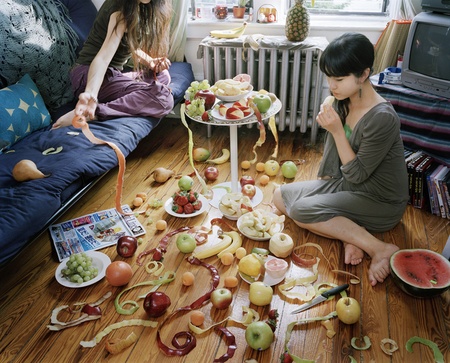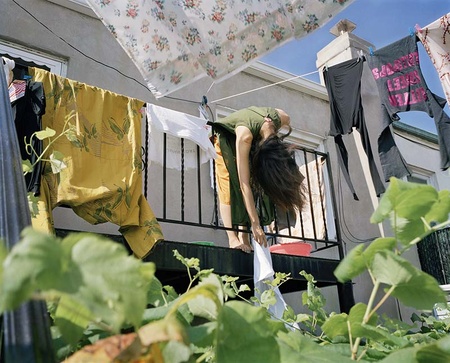Artist/photographer Satomi Shirai has found a successful creative path by exploring the feeling of being lost.
Featured in the Smithsonian exhibition, Portraiture Now: Asian American Portraits of Encounter, which recently was on display at the Japanese American National Museum, Shirai’s photography explores the feelings of disorientation when moving from one location to the next.
Born in Tokyo and a graduate of its Musashino Art University, Shirai worked as a freelance photographer until moving to New York in 2004, eventually earning a Master of Fine Arts degree from City University of New York’s Hunter College in 2010.
“My work investigates what constitutes the concept of ‘home,’ as an immigrant who chose to live in New York,” Shirai explains, noting that being a newcomer to a country makes it challenging to genuinely feel at home. “Adjusting the way to communicate was, or has still been, the most challenging and awkward for me. I think that languages, attitudes, and customs are very different in the different cultures and not easy to get accustomed to.”
The factors that influence one’s feeling of being “home” can be both tangible and intangible. In her photographic project, Home and Home: New York in My Life, she comes to grips with the dislocations caused by her move to big-city America from Japan. Ultimately, she explores the question, “How do we assess or assume home?”
“My relocation to New York is not about overcoming a culture that is distinct,” says Shirai. “But instead, it’s about encountering and understanding cultural difference and similarity. Different customs, unexpected attitudes, and struggles in adjusting myself are much involved in the creation of the works.”
For Shirai, the change in settings inspired a change in her creative process.

Fortune Telling (2007), Satomi Shirai. Digital Chromogenic print. Collection of the artist. © Satomi Shirai
“When I was still in Japan, my way to photograph were more spontaneous and documentary, chasing around and focusing mainly on the subject,” Shirai says. “But since I moved to New York I started using a large-format camera and paying attention to details in the background as well.” These details include the tableau of a person’s space, filled with personal items, which Shirai uses to convey more about the photograph’s subject.
“In my work, the presence of certain objects questions my memories, and my understanding, or lack thereof, of the world I inhabit,” Shirai explains. “I enjoy exploring environmental portraits with photography. I use architectural spaces and arrange a sitter’s personal items that can tell more about his or her life, interests, identity, and so forth. I hope to document the sitter’s state of mind with his or her facial expression and gestures in his or her living space.”
Shirai’s cross-cultural point of view has also given her some interesting perspectives on both Japan and America, and has influenced the look of her photos. “Since I started semi-immigrant life, I have experienced two worlds, with two different cultures and systems: that of Tokyo/Japan and that of New York. I came to perceive things in both of these worlds by comparing each one. I also think that the most of my way of employing colors, composition, and space both in my work and everyday life are influenced by the Japanese culture and age/era in which I grew up. You may be able to recognize those ways in the photographs I make.”
The nature of Shirai’s work has also led to some interesting comparisons with other cultures. “A Jamaican woman responded to one of my works, Fortune-Telling, which was created in response to the ways to eat apples in different cultures,” Shirai recalls. “She said that in her country there was a very similar custom and story in peeling and eating apples to that of Japan. We peel and cut apples to eat. There is a fortune-telling or popular belief in Japan: ‘if you could peel an apple without cutting in the middle, you would be able to live long.’ This was interesting to us, and we discussed that the shared custom, and theorized that it probably came from health concerns of the old days.”
Home and Home was well received and became part of Portraiture Now, organized by the Smithsonian’s Asian Pacific American Center. The show debuted at the National Portrait Gallery in Washington, D.C., and traveled to the Asia Society Texas Center in Houston before coming to Los Angeles for a four-month run at the Japanese American National Museum, a Smithsonian affiliate.
In presenting Shirai’s work, the Smithsonian described her photographs as “wonderfully overstuffed” and “sensually detailed.” A subtle, playful sense of humor is a recurring element in her imagery.
Shirai’s home life recently underwent another big change. Shirai recently had a baby.
As she thinks about the next phase of her artistry, Shirai understands that life is something that is always changing, but also something with great potential to be captured in unforgettable images.
“I try to create an experience of a moment that is in between everyday life and the extraordinary.”
© 2013 Japanese American National Museum






